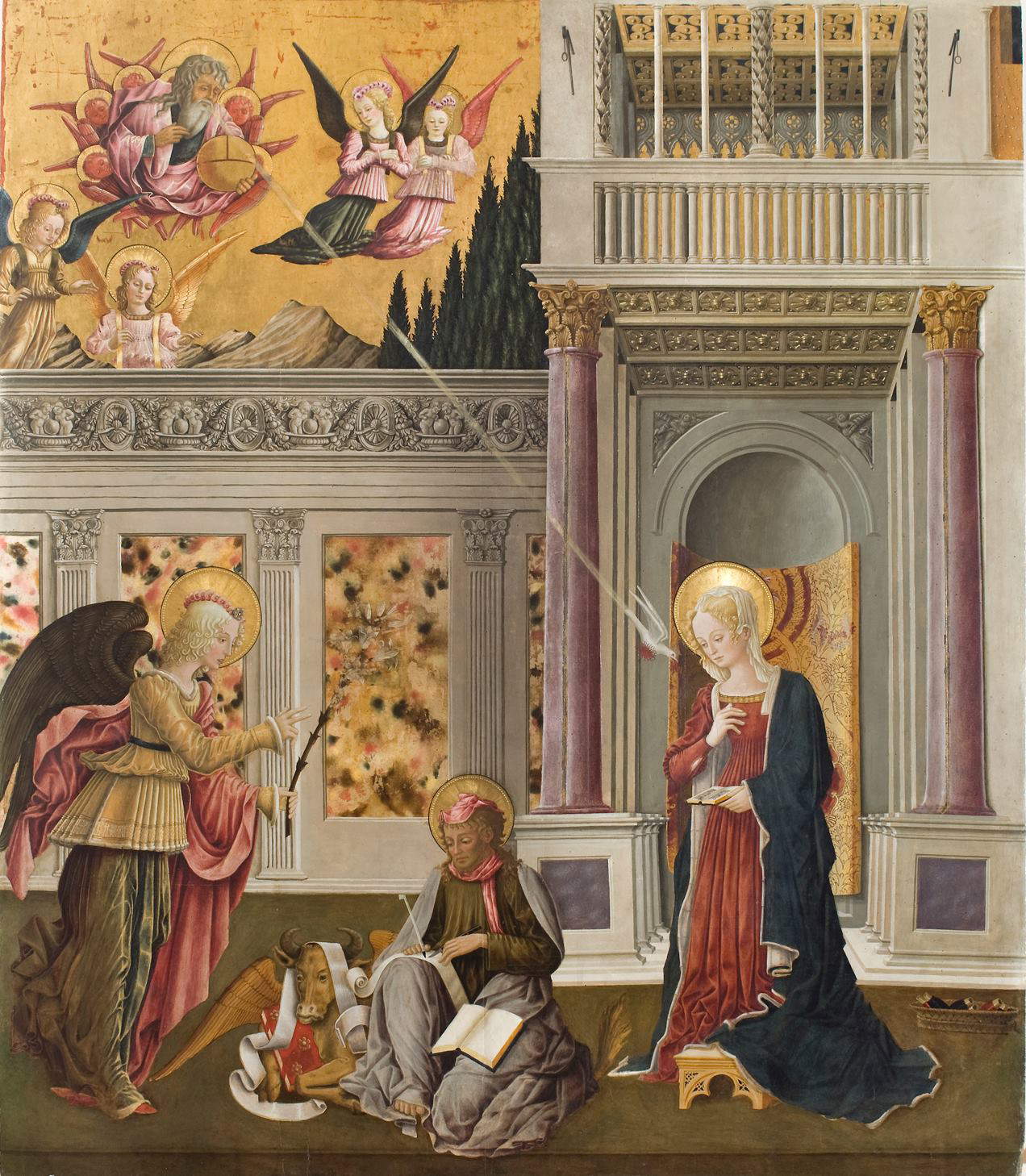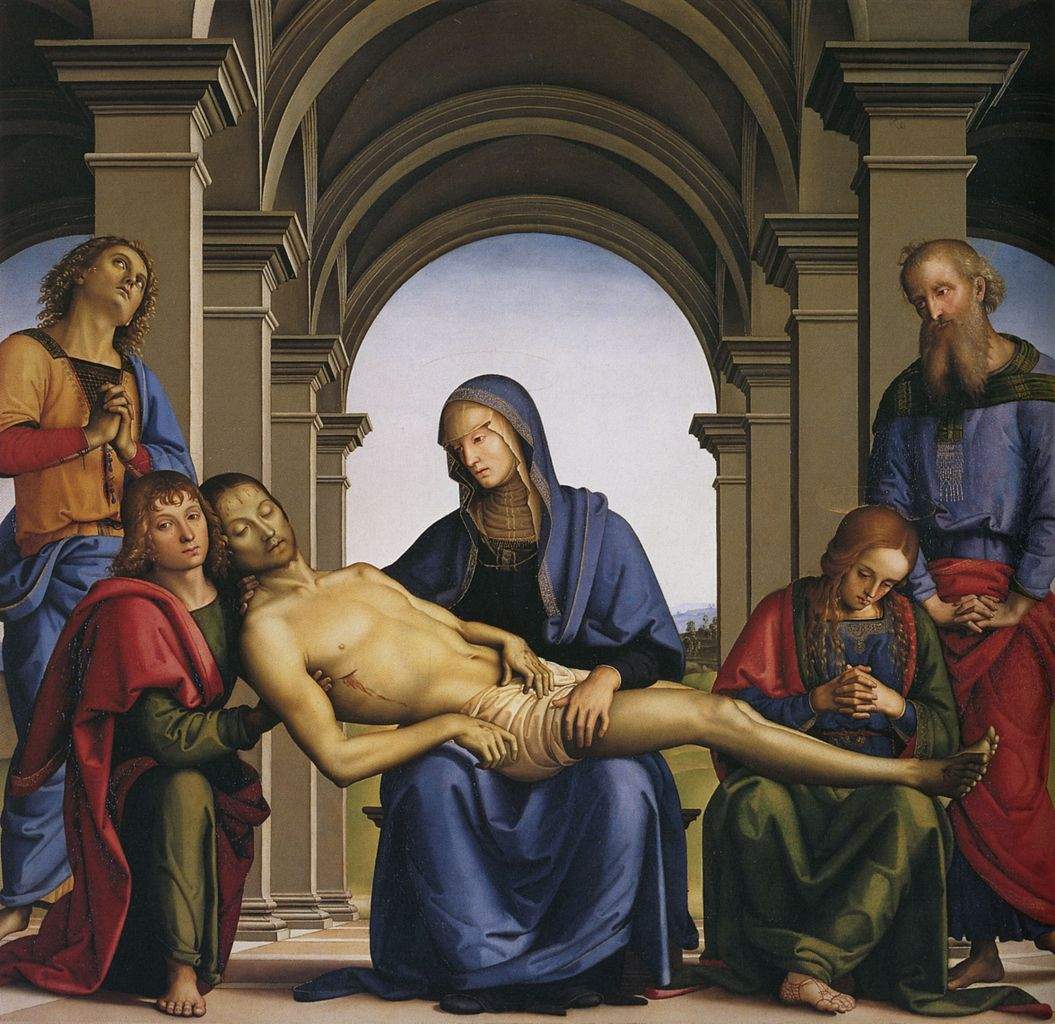One of the most artistically active areas in fifteenth-centuryItaly wasUmbria. In the region, the leading role fell to the city of Perugia, which by the end of the fourteenth century had already been transformed from a municipality to a seignory: several of the powerful local families (the Michelotti, Fortebracci, and Baglioni families, with an interruption in which the city came under the rule of Gian Galeazzo Visconti of Milan) succeeded one another in ruling the city, but in the end it was the Baglioni who prevailed. The latter obtained the rule of the city in 1424 with Malatesta Baglioni, and ruled its fortunes for over a hundred years, that is, until 1540, when Perugia lost its autonomy and became part of the ecclesiastical domains.
Baglioni rule guaranteed the city a period of long prosperity that gave a considerable boost to the local art school: thus Umbria, after more than a hundred years since the Assisi worksite, returned to the center of the peninsula’s artistic events, thanks in part to the patronage of the Baglioni family, which did not reach the heights of that of other Italian courts but nevertheless had the merit of bringing to Perugia artists who brought novelty and change. First and foremost was Domenico Veneziano, who worked in Perugia for the Baglioni and helped develop in local artists a taste for delicate and refined atmospheres. The city of Perugia also registered the presence of Piero della Francesca: many artists of the Umbrian school showed an eye for his ordered geometric rigor. Then from Tuscany came two other interesting interpreters of the Renaissance, namely Benozzo Gozzoli and Domenico di Bartolo. Minor centers in the region also hosted other of the greatest geniuses of the Renaissance: in Orvieto Beato Angelico and, later, Luca Signorelli were active; in Spoleto, on the other hand, Filippo Lippi spent the last part of his artistic career and existence.
The first of the Umbrian artists to transpose the Renaissance innovations was Benedetto Bonfigli (Perugia, c. 1420 - 1496), who completed his artistic parabola parallel to the other “progenitor” of the Umbrian Renaissance, namely Bartolomeo Caporali (Perugia, c. 1420 - c. 1505): the two were contemporaries and collaborated often throughout their careers. Their style was in some ways similar: both had been trained in late Gothic circles and both were soon fascinated by the lyrical Renaissance of Domenico Veneziano. However, it is Benedetto Bonfigli who deserves the credit for being the first to grasp the novelties, and he was the artist who was able to take a leading role in the city by winning both public and private commissions(Annunciazione dei Notari, c. 1450-1455, Perugia, Galleria Nazionale dell’Umbria). Later, however, was Bartolomeo Caporali’s attention to Renaissance novelties.
However, the credit for bringing the Umbrian school out of its regional boundaries belongs to the two great artists of the next generation, Pietro Vannucci known as Perugino (Città della Pieve, c. 1450 - Fontignano, 1523) and Bernardino di Betto known as Pinturicchio (Perugia, c. 1454 - Siena, 1513). The latter were the authors of a reinterpretation of the achievements of the masters who preceded them in the light of the most modern achievements of Italian painting. Perugino built on the delicacy of the Umbrian school, which he made his own by achieving a very high degree of lyricism that is perhaps the most obvious specification of his art, and then updated Umbrian instances first on the art of Piero della Francesca, constructing rigorous perspective compositions(Pieta, c. 1485, Florence, Uffizi), and then on the naturalism of Verrocchio(Adoration of the Magi, c. 1473, National Gallery of Umbria). Perugino was in contact with Verrocchio during his stay in Florence, a city where moreover he opened a workshop that became one of the most flourishing. The beginnings of both Perugino and Pinturicchio, and the radical change in style of the Umbrian school, are to be found, however, in a moment that marked a notable break from previous experiences, namely the cycle created by the so-called Bottega of ’73. This term is used to indicate a group of Umbrian artists (including Pinturicchio and Perugino themselves, who are assumed to have been responsible for directing the work) who authored a cycle of eight panels devoted to the Stories of St. Bernardine (Perugia, National Gallery of Umbria), which constituted the first example of the Pierfrancescan influence on the local school.
Pinturicchio started from much the same experiences as Perugino, but his art achieved quite different results. Pinturicchio lacked both lyricism and that ability to construct solemn achievements of which Perugino was often able to demonstrate. Pinturicchio’s ingenuity poured into the creation of highly imaginative works marked by a taste for decorativism unprecedented in Renaissance art (Vault of the Hall of the Sibyls, 1492-1494, Rome, Vatican City, Vatican Palaces, Borgia Apartment). A fundamental event contributed to the formation of Pinturicchio’s taste, namely the discovery of the ancient frescoes of the Domus Aurea in Rome: Pinturicchio was among the first artists to observe and study these extremely rare paintings that came from imperial Rome, and he was able to re-propose ancient decorative motifs in his art, reworking and adapting them to modern taste. Pinturicchio excelled in fresco technique and was one of the greatest frescanti (i.e., painters devoted to fresco painting) of his time.





Rome, the capital of the Papal States, did not have its own artistic school at the beginning of the Renaissance: the birth of the Renaissance in Rome was due to the presence of foreign artists. The first pontiff to enact the will to pull Rome out of its fourteenth-century artistic torpor was Martin V: he ascended the papal throne in 1417 after a council held in Constance and arrived in Rome only in 1420, realizing the city’s deteriorating condition, he began his work of urban arrangement and renewal. This modernization work was matched by a renewed passion forclassical antiquity that brought several foreign artists to Rome with the intention of studying the art of ancient Rome, so much so that the three fathers of the Renaissance(Filippo Brunelleschi, Donatello and Masaccio) were present in the city. Later, under the pontificate of the pope-humanist Tommaso Parentucelli, who ascended to the throne of Peter as Nicholas V, a refined humanism that laid the foundations for the later development of the arts also began in Rome. In the years between the fifth and sixth decades of the fifteenth century, humanists such as Leon Battista Alberti, a personal friend of Nicholas V, and Lorenzo Valla, one of the greatest philologists of the time, worked in Rome. With the help of the literati present in Rome, Nicholas V was able to begin the establishment of a Library that would later become the Vatican Library, still one of the most important in the world. Also Niccolò V was the first pontiff who sensed the role of art in conferring prestige on his state, so much so that he called artists such as Benozzo Gozzoli and Beato Angelico to the city: the latter was the author of the frescoes in the Niccolina Chapel, one of the most important cycles in Renaissance Rome. The humanist tradition in Rome then continued with Pope Pius II, born Enea Silvio Piccolomini, another important humanist who gave an exceptional boost to the study of letters.
All of these pontiffs had also been able to greatly enrich the Church State through shrewd economic and fiscal policies: thus, when Francesco della Rovere was elected pope in 1471 under the name of Sixtus IV, the pontiff could dispose of substantial capital to invest in the artistic and cultural enrichment of Rome. Sixtus IV was an extremely nepotistic pope, a weaver of political intrigue (he clashed bitterly with Lorenzo the Magnificent in an attempt to bring the influence of the Papal States down to Florence, and became embroiled in the war between Venice and Ferrara) and practiced customs that went sharply against evangelical dictate. He was also, however, one of the most exalted patrons of the time: he stimulated the study of letters by inviting humanists such as Platina and Pomponius Leto to the papal court and initiated some of the most artistically significant works of the time, foremost among them the Sistine Chapel, which he named after him. For the realization of this magnificent work of art, completed in 1483, Sixtus IV called to Rome the greatest of the time-Sandro Botticelli, Domenico del Ghirlandaio, Cosimo Rosselli, Perugino and their collaborators, many of whom would later become other great artists in their turn(Luca Signorelli, Bartolomeo della Gatta, Biagio di Antonio and Piermatteo d’Amelia). Again Sixtus IV then called to Rome other greats of the time who were, however, engaged in other works: Melozzo da Forlì, who assumed the role of pictor papalis, official painter of the papal court; a young Filippino Lippi, who probably arrived in the wake of Sandro Botticelli; and Antonio del Pollaiolo, who was commissioned to execute the pope’s funeral monument.
The pontificate’s work of artistic enrichment then continued with Sixtus IV’s successor (who died in 1484), namely Innocent VIII, and especially with Alexander VI, another nepotistic pope with morals openly opposed to those of the Gospel, for whom Pinturicchio (previously called to Rome by Innocent VIII) carried out the decoration of the pope’s private apartment, known as the Borgia apartment (the Spanish pope’s secular name was Roderic Borja, Italianized as Rodrigo Borgia), where the painter’s imagination and decorativism found vent in completing the work most illustrative of the taste for luxury of the popes of the time.
It has been said that Rome had no art school of its own, but in such a culturally and artistically vibrant context an isolated figure emerged, that of Antonio Aquili known as Antoniazzo Romano (news from about 1452 to 1510), the most important Roman artist of the time. Antoniazzo Romano had the opportunity to see the works of all those painters who were coming to Rome (mainly Melozzo da Forlì, whose collaborator he was also under Sixtus IV, Benozzo Gozzoli and Perugino), which he was able to rework to create an entirely personal style made up of a composed and sereneelegance, also capable of a wide and conscious use of ancient legacies such as the gold background(Annunciation, c. 1490-1500, Rome, Santa Maria sopra Minerva).

 |
| The Renaissance in Umbria and Rome. Origins, developments, artists |
Warning: the translation into English of the original Italian article was created using automatic tools. We undertake to review all articles, but we do not guarantee the total absence of inaccuracies in the translation due to the program. You can find the original by clicking on the ITA button. If you find any mistake,please contact us.